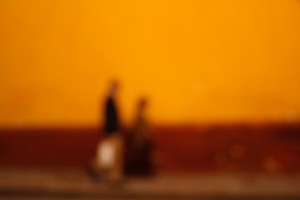As published in the Atención San Miguel newspaper, San Miguel de Allende, Mexico
Seeing San Miguel for the first time, again.

Do not adjust your Monitor. This picture is blurry. Read on to find out why.
Remember the first time you laid eyes on San Miguel de Allende? I don’t, but I imagine it must be a splendid sight. Unforgettable, even.
My first eyeful came in 1969, when my bohemian mother moved us down here (I was 18 months old). While mom learned to paint, I learned to speak. Along with the smell of linseed oil, I got very used to San Miguel’s riot of shape and color.
Our little time-warp municipality, with its unique palette of ornate colonial architecture, blazing colors and improbably blue skies, should be enough to provide daily delight for anyone’s retina. But I have to admit I seldom see the beauty that surrounds me.
I pass by our improbable pink cathedral nearly every day, but months will go by without me looking up at it at all, much less in wonder. It seems I’ve succumbed to one of the risks of living in a postcard place: I’ve developed immunity to it.
My ambient blindness is a serious problem. If I’m not seeing San Miguel, I might as well live in Detroit. (I hear parking is easier there.) So I formulate a plan.
Each October, throngs of photographers descend on San Miguel under the auspices of the Santa Fe Photographic Workshops. They come to indulge their photographic obsessions, to hone their skills, and to find inspiration in our abundance of eye candy. Last year, I joined them.
With income in mind, the small, adult part of my brain chooses a workshop called “Travel Stock Photography.” But really, what I want from this course is a reintroduction to my hometown.
…
Just before sunset on a Sunday evening in early November, I wander into the courtyard at the Hotel Posada de La Aldea. We, the workshoppers, are to meet for drinks before orientation. A chilly fall breeze blows, rustling the leaves of the ficus trees. The sound of shutters whirring competes with the trilling of the crickets—the place is crawling with photographers.
As the light fades, they reluctantly detach their faces from their equipment and gravitate over to a cluster of wrought iron tables, where a bar has been set up. Inadequate schmoozer that I am, I’m a bit tense. So many new people, and I’ve never seen such big lenses. (My camera, I realize, is woefully inadequate. My lens is Lilliputian.)
Aside from being quite friendly, my new comrades are dedicated photophiles. Entirely willing to forgo the leisure part of travel, they’ll spend the week shooting from golden hour to golden hour, edit long into the night, and not feel they missed a thing. As a frizzy-haired woman next to me, hugging a camera the size of a toaster says, “What could be better than spending a week with your camera and new friends in an exotic place?”
…
Monday morning. After an early breakfast with Santa Fe faculty and fellow enthusiasts, we file into our conference room/classroom at the Aldea. The lights soon go off and the images go up. Each participant has prepared his or her ten best-ever photographs for this introductory show.
Seeing each person’s work is illuminating — a bit like looking inside them. We get a glimpse into each other’s quirks and affinities, style, and “eye.” Then it’s time for class.
Unlike most Santa Fe workshops, a large part of ours is lecture, stock photography being a singular and exacting genre. Normally, spending several hours a day taking notes and looking at slides in a dark room isn’t the ideal way to pass the time in a major travel destination like San Miguel. But in this case, it’s perfect.
First, because instructor Patrick Donehue—ex-vice-president of Corbis, the world’s number two stock photo emporium—is as engaging a speaker as he is encyclopedic about his field. Second, because it’s all about photography. What could be dull about that? The morning flies by.
In the afternoon, we are let loose on an unsuspecting San Miguel with two assignments: to take quality photos for an imaginary high-end travel article, and to garner great stock photography. Images that—if we are very lucky, skilled and savvy—could make us a fortune (or at least pay for a cappuccino at Cafe del Jardín).
Before setting out, I pore over my notes and compile a meticulous shooting schedule. Once behind the camera, however, the plan flies out of my head and I find myself compulsively clicking away. Then the sun is setting.
The five intervening hours have somehow vanished, and the molten light has my brain tingling. I run into our instructor in the Jardín. “The town is sparkling,” I babble. He smiles. I’m still out on the town at 7:00 pm, when it’s time to go to the Angela Peralta for photo presentations by the week’s faculty. More inspiration. More eye food. It’s a feast, and I’m pigging out.
I head home around 9:00, yearning for rest. But I have homework: comb through more than 500 pictures, try to pick ten worthy of imposing on my group tomorrow, and then tweak them on the computer.
When I finally get to bed, I can’t sleep. I can only think about images I’ve seen, made or might make tomorrow. Much later, I doze off—only to dream about taking photos.
…
Tuesday begins with everyone’s Monday best, and I’m eager witness to my classmates’ first impressions of San Miguel. Despite feeling like I may have seen it all around here, many of their images are surprising, fresh—new, even. Maybe I’m on the right track here.
We move on to lecture. I’m a bit distracted. While I’m sure it’s vital to know about the different stock photo rights and payment systems, I’m itching to get out on the streets again.
Peering through the viewfinder that afternoon, I’m less frenzied than the day before. After all, I think, I do live here. I could do this every day. So I try to stroll. Take my time. Before long, I am happy, very happy. Also slightly insane. Shameless, I accost complete strangers to get a picture, chatting them up in the hopes of coaxing a natural look.

San Miguel de Allende street musicians on a break
I approach the young woman selling esquites (corn on the cob with mayo and chile); four members of the Tuna Oratoriana—buskers in antiquated velvet costumes complete with puffy sleeves; five teenagers lolling on the cathedral steps; mariachis chatting on cell phones; the newspaper vendor; the shoe-shine guys; all my favorite waiters. Apparently, no one is safe from me when I’m armed with a camera.
…
Wednesday brings a discussion of trends in a different kind of stock market. After class, I go to market—specifically, the Mercado Principal, where my mother used to take me as a child to get produce and flowers. I still frequent the place in search of my own bouquets, but his time, the old mercado is transformed.
Mounds of Technicolor fruit beckon sweetly. The veggies exude a savory allure. I lose myself in photographing a shy young girl at a torta stand festooned with religious icons; a laughing man making licuados for friends; a tangled profusion of flowers; legume vendors entranced by the telenovela that echoes from nearly every stand; an icon of the Virgin Mary haloed by the colors of the Mexican flag—jalapeños, red chiles and onions. Hours later I emerge, rapt.
…
Thursday, our last full workshop day, means more in-class enlightenment—portfolios, agencies, money matters—and our final afternoon of shooting. By now, I figure, I should be a seasoned pro: my vision keen, my images impeccable, my trigger finger honed and twitching slightly as it hovers over the shutter button.
Instead, I am lethargic, paralyzed by an utter lack of inspiration. Listless, I roam the streets of my picture-perfect town, half-heartedly waving my inferior camera around. People, color, old buildings. Yeah, whatever. This must be burnout from an intense week.
At a loss, I start messing around with my focus ring. I take a deliberately blurry picture. Before I know it, I’m in the zone, annoying taxi drivers who do not appreciate my squatting in middle of the street to get the perfect shot. I end up with 206 decidedly not-sharp pictures of Hidalgo Street.
The vivid red, ochre and pink buildings, the darker rooflines zigzagging against the blue sky, the cobbled street leading out of the frame and into parts unknown. Ahh. Another indistinct image traces the soft white arches of the church on San Francisco behind a dreamy soft palm tree. Ahh. For some reason, these pictures bring back my childhood. (Was I nearsighted as a kid?)
Instead of wasting a day, I feel I have captured the smallest bit of the essence of my own San Miguel. The magic of this town, I realize, resides not only in the fine details of its historic architecture, or even in its singular people.

Abstract San Miguel de Allende palm with church spires
It’s also there in the abstract—in large blocks of rich color, in the geometry of stonework accent lines, and in the cerulean sky embracing it all. So, I spend my last afternoon of directed shooting drunk on beauty and, once again ignoring the assignment, cruising the calles with my pupils dilated and my lens unfocused. My town, once again, is splendid.
…
On Friday morning, the group is very kind about my images, but I‘m pretty sure they think I’ve lost it. Huh. Maybe she dropped her camera? Maybe a screw or two did unwind, but of the ludicrous number of images I’ve shot this week, these are my favorites.
Of course, my blurred epiphanies are not included with the sharper images in the Friday night dinner show, celebrating our week of work, but I still love them. Partly because my brain tingles when I look at them, and partly because they are physical proof that I found a way to really see my hometown in all its glory, without recourse to psychotropic substances.
It’s been nearly a year. Sometimes I still forget to see. There I am in the car, cursing the kid on the four-wheeler that just cut me off instead of enjoying the color of the morning light on a stone lintel, the burnished glow of an umber wall.
Fortunately for me, in San Miguel, beauty is always just around the corner. All I have to do is open my eyes. And take another workshop.
(As published in Atencion San Miguel)

 Big Magic is not a fluffy self-help book on how to unleash your wildly artistic archetypal/goddess self. It’s an accessible yet philosophical meditation on fundamentally re imagining your entire relationship to creativity, for very practical reasons. Simply put, Gilbert wants you to revamp your expressive mindset in order to be more productive, yes, but most importantly, to be happier.
Big Magic is not a fluffy self-help book on how to unleash your wildly artistic archetypal/goddess self. It’s an accessible yet philosophical meditation on fundamentally re imagining your entire relationship to creativity, for very practical reasons. Simply put, Gilbert wants you to revamp your expressive mindset in order to be more productive, yes, but most importantly, to be happier.





